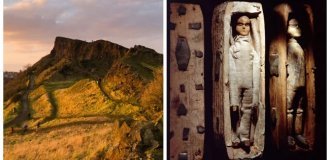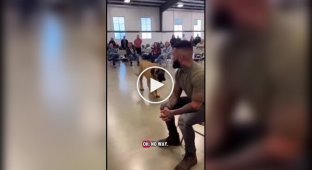A selection of interesting and unusual photographs from the USA (21 photos)
All photos were taken in the 20th century and show well how Americans lived in different decades. All photos were colorized and restored. 
Hospital library. USA, 1955. 
Hippies protest against the law banning living in cars, 1969.
Hippies were fun guys, they had fun all over the world and made people laugh. They didn't get "green" money, they just did what they thought was right and lived their own special life. 
A huge teapot over the door of the Oriental Tea Company in Scollay Square, Boston, 1934.
If you look closely, you can see the volume of this advertising teapot: 227 gallons or 1035.21 liters. An advertisement overhead with a ton of water. That's if it were filled. 
A Chicago postman poses with heavy Christmas packages, 1929.
The man looks very pleased, apparently he loved his job. Like a fairy tale character. The postman does all the hard work, and Santa gets all the credit. 
The New York Central Mercury liner passes through Syracuse, New York, 1936.
All Mercury family trains were built as complete solutions. That is, each train was built for a certain number of cars + locomotive.
For the first time in world railway history, the axles of all trains (both in the locomotive and in the cars) were equipped with rolling bearings (ball bearings), instead of the plain bearings that were used everywhere at that time.
Thanks to this solution, the established cruising speed of the train was at the level of 80 miles per hour (130 km/h). At the same time, contemporaries said that the train easily made up for lost time during accidental delays, accelerating to 100-120 miles per hour (160-190 km/h).
The main agenda in the news about the operation of the Mercury family of trains were incidents with accidents at unregulated crossings with highways. People of that time could not get used to such speeds (to understand the speed of the approaching train) and tried to slip in front of the approaching train.
Almost all routes were closed and liquidated in the late 1950s.
The Cardinal train, operated and serviced by Amtrak, has survived and continues to operate to this day. Route one: New York City (New York State) - Chicago (Illinois).
Route length: 1,146 miles (1,844 km). Travel time: 27 hours 45 minutes. Average speed: 41 mph (66 km/h), with increases to 125 mph (201 km/h). 
Christmas toy sales in New York City, 1910s. 
Members of a Baptist church at a baptism in a river. Kentucky, 1940.
The use of water in baptism has deep spiritual significance. It is a powerful symbol of cleansing, purification, and renewal. When someone is baptized, they are essentially washed from their sins and begin anew with a cleansed soul. 
Teenagers at a party in Tulsa, Oklahoma, in 1947,
The shot seems very staged, and perhaps even an advertisement. The well-known American soda is in the frame too strangely. 
Children from the Arizona desert decorate a cactus for Christmas due to the lack of a Christmas tree. USA, 1959.
A very beautiful, cute and positive photo! Someone replaces the Christmas tree with a cactus, and someone replaces the palm branch with a willow branch. 
A lady, a horse and a policeman in Golden Gate Park in San Francisco, 1937.
Judging by the boots and breeches, the policeman is not quite ordinary. 
A priest on skates, Detroit, Michigan, 1954. 
Fashionables on the streets of New York, 1930s.
America is a melting pot of many nations, as I. Zangwill wrote in his play "The Melting Pot" in 1908. Therefore, the people in the photo may well be immigrants. 
A miner's family home in one of the poorest areas of the United States - Kentucky, 1946.
I wonder how old the mother is? She looks like an old woman, although the children are still very young. Poor people are equally unhappy regardless of the country of residence... 
Food truck. USA, 1919.
It seems that the average girl faints from hunger at the sight of food, and she is supported by... 
Women undergoing a weight loss course in a courtyard in New York, 1926.
The United States of America is now in the top 20 countries in terms of obesity rates among the population. 
A boy with a sign: "Who needs ni**ers", Little Rock, Arkansas, 1959.
No comments here... 
On the beach. USA, 1958.
The photographer was most likely taking the picture from a lifeguard tower. The girl's shadow turned out funny. 
An unusual cafe in Los Angeles in the 1920s.
It's hard to surprise anyone with something like this now, but a hundred years ago it was quite interesting and unusual to dine in such an establishment. 
Sunset Boulevard, Beverly Hills, 1925.
If at the end of the 19th century the population of Los Angeles was about 50 thousand people, by the 1920s it was already a little more than 500 thousand, and today the population of Greater Los Angeles is more than 17 million people (not the city, but the entire agglomeration). But at the beginning of the 20th century these territories were a desert. 
Waitresses. USA, 1940s. 





















